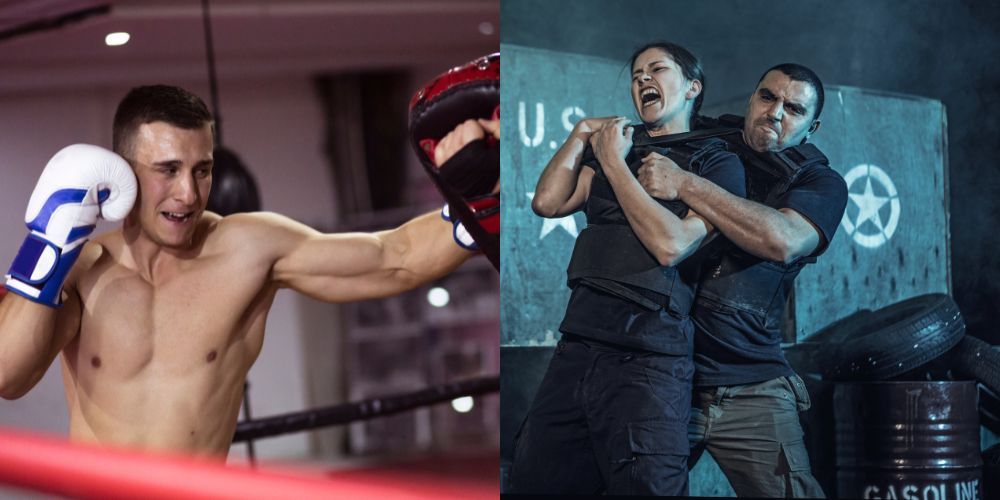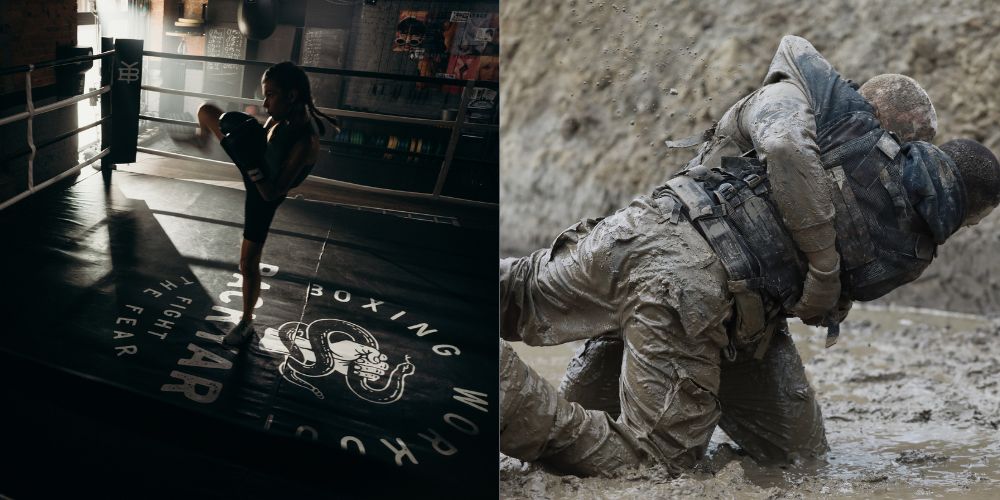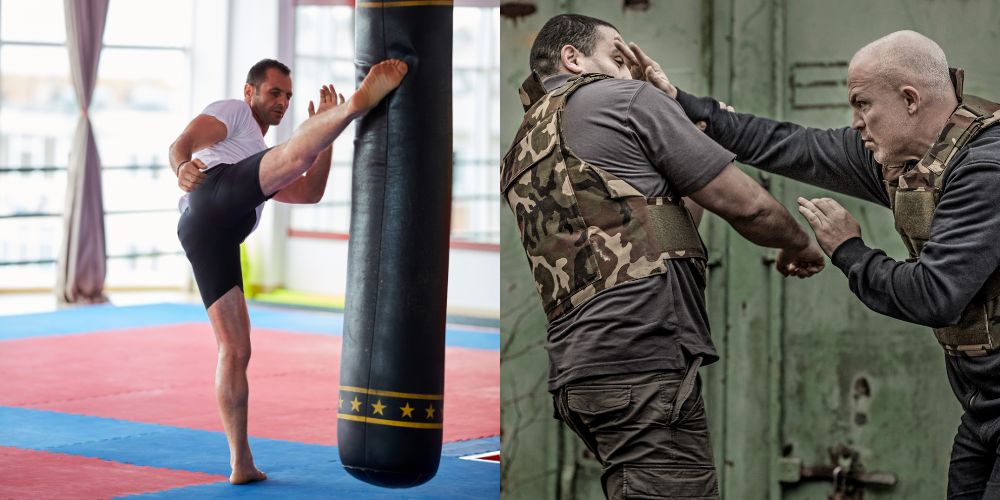Combat sports are just that- a sport that simulates combat. But even as a simulation, a punch, a kick, and a choke feel all the same regardless of whether thrown in the gym or in the street, which is why I believe combat sports are excellent for self-defense. But then there are systems specifically created for self-defense, like Krav Maga, which claim to be much better. But how good is Krav when compared to kickboxing?
Krav Maga is a self-defense system that teaches you to fight without rules and restrictions in all kinds of situations. Training with resistance and pressure testing can be a great way to learn simple but powerful tools for self-defense. Kickboxing, on the other hand, is a regulated sport, but its full contact and competition make it also very good for self-defense because these skills are transferable to real fighting.
On paper, Krav Maga is perfect for self-defense, but in reality, way too often, it fails miserably, and a lot of this depends on the gym and type of training. This is why it’s difficult to compare it to a style like kickboxing, but here is my analysis of the good and the bad of both Krav Maga and kickboxing.
What Is Kickboxing
Technically, kickboxing can be used for all striking combat sports styles, including punching and kicking, like Sanda, Muay Thai, Savate, and many others.
But today’s term refers to a specific full-contact ring combat sport characterized by punches, kicks, knees, and no grappling.
The specific ruleset was made popular by the K-1 organizations in the 1990s and is still often called by this name, regardless of which organization is holding the event.
Kickboxing was created in Japan by blending Karate and Muay Thai, but there have been many variations throughout the 20th century.
Distinct schools and sub-styles like American kickboxing, Dutch kickboxing, and Japanese kickboxing were created. They all collided under the K-1 banner within a specific ruleset, prioritizing fast-paced stand-up action.

How to Dominate Every Fight with Raw, Explosive Power No One Can Match
Discover the underground blueprint that has quietly turned MMA hopefuls into legends, using nothing but sheer, brute force and bulletproof conditioning techniques.
All kinds of punches and kicks are allowed, knees can be thrown from a distance, and elbows are banned. Clinching is also quickly broken up, so all grappling elements are absent.
K-1 started (or at least popularized and systematic) kickboxing as a sport as we know it today.
While its popularity has waned in comparison with MMA, big organizations like Glory, One FC, K-1, and many others still hold high-level kickboxing competitions around the world.
What Is Krav Maga
Krav Maga is a self-defense system designed to neutralize attackers as quickly and decisively as possible without reservations. It has no sports elements and competitions and thus has no rules.
The history of Krav Maga begins on the streets of 1930s Bratislava, Slovakia, where Hungarian-Israeli Imi Lichtenfeld used his extensive boxing and wrestling skills to fight against antisemitic gangs before World War 2.
After the creation of Israel in 1948, he devised a complete system for the Israeli Defense Forces. The result was the creation of Krav Maga, which means contact combat in Hebrew.
The system was designed with soldiers in mind, so the techniques usually included weapons and full body armor. The super-aggressive mindset and direct techniques are truly effective for military purposes.
Gradually, the system reached the civilian population and shifted its focus to this most lucrative niche. And because civilians usually don’t walk around with assault rifles and knives, more and more elements from other martial arts were implemented.
Today, Krav Maga is more than an umbrella term for schools teaching self-defense; the methodology taught can be worlds apart.
Key Differences Between Kickboxing And Krav Maga

Philosophy And Goals
As any Krav Maga practitioner will quickly point out, the most significant difference between the two styles is that kickboxing is a sport while Krav Maga is a fighting system for real life.
This key distinction determines all the techniques, training methodologies, and results.
Krav Maga was created as a close-range system to be taught to military personnel. Gradually, it branched off as a civilian self-defense system emphasizing natural movements and instincts.
The key concept is surviving and neutralizing an opponent as quickly and effectively as possible with any means necessary, meaning no technique is off-limits.
This creates a tremendous amount of variability and potential situations, just like it is in real life.
Kickboxing, on the other hand, is a tightly regulated sport with strict rules. Fights are conducted at a set time in a safe ring and under the supervision of referees.
The rules of a combat sport also determine the tactics, so some techniques and strategies become more favorable due to scoring.
This means kickboxing prepares you for a lot fewer possible situations and, at least on paper, is more limited in scope than the well-rounded nature of Krav Maga.
Techniques
Kickboxing, as the name would suggest, involves punches and kicks. Punching is very similar to boxing, with the standard array of straights, hooks, uppercuts, and all possible variations of these fundamental punches.
While punching is not at the level of pure boxing, some fighters who rely more on their hands reach super-high levels of proficiency.
The kicks come from different martial arts, and depending on the school, they can vary in diversity and execution.
Some schools prioritize karate-style kicking (snappy kicks landing with the foot), while others prefer Thai style (big load-up kicks landing with the shin). There are front kicks, side kicks, spinning kicks, and every other type of kick.
In the professional rulesets, knees are usually allowed, but without grabbing the opponent. Kickboxing is created to be a fast-paced stand-up action affair, so no grappling and clinching whatsoever are allowed or used.
Krav Maga, on the other hand, takes techniques from everywhere. Since it aims to prepare you for many situations, you will learn striking, clinching, takedowns, and some joint locks.
Whereas combat sports have rules, in Krav Maga, attacks to vulnerable areas like the neck, eyes, and groin are incentivized.
Additionally, Krav also deals with weapons, so knife defense and disarms, as well as gun disarms, are part of the curriculum.
Training

The reality is Krav Maga is not a uniform and regulated system. There is no quality control, and the lack of real testing in the form of competitions means every teacher is free to teach whatever he wants under the Krav Maga name.
So, someone can just come up with stuff (often the case) and teach it to students under the pretense of mastery, which is not proven or supervised.
Today, there is a huge variance in Krav Maga schools. Depending on the instructor’s expertise, there may be sparring or not. I’ve seen videos of some very interesting situations sparring with unexpected factors or time of attack.
Other schools are run by people with combat sports experience (similar to the creator Imi), and they teach legitimate fighting skills in a way more applicable to real life, which I believe is a great approach.
But from what I’ve seen and heard, most Krav Maga schools drill against a willing training partner and do a lot of pad work.
In essence, it’s something like MMA training, but worse because it lacks the sparring and live resistance drills. It turns a perfectly working style into a watered-down, theoretical version.
Equipment
Kickboxing is striking only, so training will require to have the standard set of protective gear inherent for these styles, namely:
- Mouthguard
- Kickboxing gloves
- Shin guards
- Headguard
- Fight Shorts
Krav Maga training depends on the gym you are at, but in general, you will need the same things as in kickboxing with a couple of additions like:
- MMA gloves
- Headguard with some kind of face shield
- Training weapons (if that’s a thing at your school)
Kickboxing vs. Krav Maga For MMA
Kickboxing is a critical component in MMA, so it’s drastically better than Krav Maga for MMA.
This is not a significant loss on Krav’s part since the system was never intended for sports use in the first place. So, if you want to learn striking that you will eventually be able to use in mixed martial arts, directly choose kickboxing.
Kickboxing vs. Krav Maga For Self-Defense

Here comes the controversial part. Kickboxing is much better than Krav Maga for self-defense, even though this is the sole purpose of the latter. Let me tell you why.
As I’ve said in my Krav vs. MMA comparison, there is a simple question you need to answer to understand if your Krav Maga gym will teach you how to defend yourself or not.
If there is live sparring and drilling against a resisting opponent, the training is intense, and there is a chance of injury, it may teach you something. If there isn’t, then it’s just a pile of crap.
If we compare kickboxing with the first type of gyms, which sadly are hard to find, Krav Maga may be better for self-defense because you will learn skills and do situational sparring, which is not found in any combat sports discipline.
But let’s compare kickboxing to the vast majority of Krav Maga, which falls in the second category (training without pressure testing). It’s like comparing the cutting capabilities of a steel knife versus a plastic one.
The only way to learn legitimate fighting skills is to apply them against fully resisting opponents in the form of sparring, or better yet, in competition, because the intensity and mindset are entirely different than in the gym.
Kickboxing is a highly competitive discipline, so everything done there works (albeit within a limited ruleset) and is constantly tested.
On the other hand, Krav Maga falls in the same pitfall as every other martial art that doesn’t do sparring and competitions because the techniques are “too deadly.”
Ultimately, it’s just a watered-down version of existing martial arts with no real practicality.
Kickboxing vs. Krav Maga: Which Is Better?
Despite what I’ve said, Krav Maga has some benefits over kickboxing. The military version is a separate topic because it deals with different factors, and timeframes are not comparable to the civilian version we are discussing.
Krav Maga can serve as a good introduction for people to different martial arts and techniques.
It can demonstrate some core principles of striking and grappling, and its biggest asset is the instillment of an aggressive mentality and situational awareness.
It can be an excellent option to get an overview of things quickly, similar to what is done in military boot camps.
But kickboxing is much better if we are talking about real fighting skills, even with the complete lack of grappling in it.
As a competitive combat sport, learning to punch, kick, and defend against a person attacking you for real is part of every training session.
Then there is the physical training and attributes developed by and for kickboxing, which are great for all purposes.
My advice for all who want to learn to defend themselves is to train in a legitimate combat sports gym, be it kickboxing or something else, and then find a good Krav Maga academy where you can test and adjust your skills outside of the constraints of the typical rulesets you are used to.

